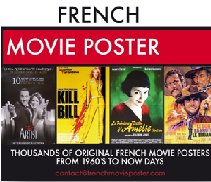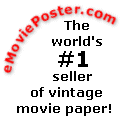The
terms "movie art," "theatre art," and "theatre
paper" generally refer to any number of advertising materials
that feature the artwork created for a particular film. By the mid-1910's,
with the movie industry exploding, movie studios and film exhibitors
utilized these advertising tools in one of three ways:
Display
In and Around a Theatre
Materials
used for display purposes included the different types of movie
posters, lobby cards, inserts, banners, etc
Press
Information Dissemination
Press
information was provided to the media (newspaper and magazines and later
radio, TV, etc) in press kits, campaign manuals, press stills, etc.
Promotional
Giveaways
Promotional
giveaway items included just about anything that has the movie's title
or artwork printed on it AND was given away at a premiere or special
showing.
DISPLAY
Movie
posters were some of the earliest forms of "movie art."
The first movie posters came in a variety of shapes and sizes. Before
long, however, the movie industry adopted some of the popular standard
sizes and types being used in other entertainment fields (i.e., the
circus, fairs, and vaudeville). These posters were printed on paper
and came in four incremental sizes. They were:
While these sizes were very popular, theatre owners and movie exhibitors
wanted more variety in their advertising materials. The Trust, along
with the major independent exhibitors, introduced a new series of
posters printed on card stock. They recognized that card stock items
were more durable and could be re-used. The earliest forms of the
card stock posters were:
They later added other sizes of card material, including:
As the movie industry grew, the movie studios provided their exhibitors
with more unique or more elaborate display materials, particularly
for larger advertising campaigns. These included:
In addition to the materials produced for the theatre lobby displays,
movie studios also released a series of window card posters to be
displayed in places OTHER THAN INSIDE AND OUTSIDE OF THE THEATRE.
As
the industry grew, movie studios took advantage of the growing transportation
industry by adding larger, more visible posters. These included:
This
above list of sizes and types is by no means inclusive. There are
always exceptions, as movie studios from time to time would produce
specialized products for a particular film. However, those listed
are the most commonly used posters.
Posters
for Display
In
addition to their artwork, most of the posters used for display would
contain some or in most cases, all of the following information:
The
Film's Title
The Film's Stars - In the early days, the placement of the names
on the poster would indicate the actor's "pecking order."
The
Film's Producer, Production Company and Director
Miscellaneous information such as musical score, screenplay, distributor,
etc.
Copyright information and protection clauses.
The Litho Company - This applies primarily to pre-1950's material.
Ownership
Tag - National Screen Service also included numbers along with their
tag information.
In
order to give theatres supplemental information, revised information,
or provide "stock" information, the studios issued a "snipe."
A snipe is basically a piece of paper with additional information that
is pasted, stapled or somehow attached to an existing poster. (for more
info see Snipe)





